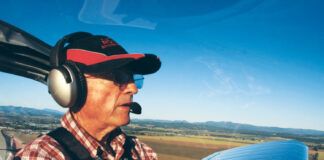Classic Aero Machining
For those seeking an authentic, full-gyroscopic rotary experience, New Zealand-based Classic Aero Machining has developed brand-new seven- and nine-cylinder Gnome Monosoupape engines. They are faithful continuations of the Gnome used in many French, English and German aircraft just prior to and during WW-I.
While using original plans and remaining incredibly period correct, CAM has made some welcome improvements to this 110-year-old design. These include a pre-start oil priming system and lengthening the lower portion of the cylinders for improved piston support. The induction ports are now angled, promoting in-cylinder swirl for better fuel atomization and reduced plug fouling, a big help there. The in-cylinder motion is further aided by CAM’s fuel pump (the originals relied on gravity). Finally, there is an electric starter.

The new seven-cylinder produces 100 hp at 1150 rpm; the nine-cylinder makes a muscular 125 hp and nearly 600 pound-feet of torque while whirling at just 1120 rpm.
The CAM story is augmented by KipAero in Dallas, Texas. KipAero offers their own line of uber-authentic continuation WW-I Sopwith airframes using the CAM rotary and works very closely with the New Zealand firm.
Motorstar NA
Few homebuilts can take all the muscle a Soviet-era 621-cubic-inch M14 radial can dish out. But hang-on-the-prop sport pilots and Murphy Moose drivers need all they can get. For them, the Romanian-built M14 provides the huge torque and long-prop compatibility they’re looking for.
Importantly, the venerable supercharged 360-hp M14 radial is a Russian design built in Romania by Motorstar. Today Motorstar fully supports the M14, but recent Russian embargoes mean Russian parts cannot be exported. Therefore, Motorstar has to build them, raising prices “considerably” but by an unknown amount at our deadline. Another change is that North American Motorstar distributor Coy Aircraft Sales in Swanton, Vermont, has been taken over by son Cliff Coy as father George has retired.

Coy Aircraft offers overhauls via shipping core engines to the Romanian factory, which includes all rebuild work, a test run and warranty. This is the typical method of obtaining a fresh M14 as factory-new engines are prohibitively expensive. A factory PS conversion, easily done at overhaul, raises power to 400 hp.
Alternately, Barrett Precision Engines in Tulsa, Oklahoma, has their own rebuilt/upgrade program for these engines using a three-ring piston, higher compression ratio, electronic ignition and fuel injection to yield 440 hp at 2900 rpm.
Rotec Aerosport
Rotec radials are naturals for the vintage round-motor look in light aircraft. The Australian company offers two nearly identical compact radials, the smaller R2800 measuring 172 cubic inches and the larger R3600 with 220 cubic inches. These are a good fit to smaller airframes popular with scale replica builders or light sport aircraft. There are no changes to either engine for 2024.
The 110-hp R2800 uses seven cylinders; the R3600 employs nine of the same cylinders and is the better-selling version. It puts out 150 hp at 2350 propeller rpm (both engines use a 3:2 PSRU gearbox, so that’s 3675 engine rpm). Neither is supercharged and while the R2800 is well paired with a 76-inch propeller, the R3600 can handle 90-inch props. Because the Rotec is fitted with a collected exhaust with two outlets, the combination of higher rpm and collected exhaust results in a smooth, medium-tone exhaust note similar to a small V-8 turning cruise rpm.

Standard Rotec induction is a simple Bing slide carburetor, but Rotec’s own—and still stone simple—TBI Mk 2 throttle-body fuel injection is optional. Its main attraction is staying on the job during aerobatics. Besides fitments for their radials, Rotec does a brisk business offering versions of their fuel and ignition accessories for everything from VW conversions to Rotax, Jabiru and even Lycomings.
Like all radials, the Rotec scavenges oil to a remote tank and Rotec offers fabrication of such tanks to fit customer aircraft as an optional extra. After 25 years on the market, the Rotec has been mated to a large number of airframes, so it’s worth checking with Australia about a tank before assuming you’ll have to fabricate your own.
Verner Motor
Relatively new Czech engine maker Verner Motor has had a great start—their generous-displacement, slow-turning, non-geared radials offer the sort of long prop, deep rumbling that makes round-motor fans a little weak in the knees. A good customer service reputation and help with installations haven’t hurt, either.
Currently Verner offers a five-radial lineup ranging from three to nine cylinders. All use the same two-valve, 3.62×4.02-inch cylinder, but fit five, seven or nine of them as power needs rise. Designed for 93-octane U.S. or 95-octane European premium mogas, these Scarlets span a 32-inch diameter and carry a 1000-hour TBO (expected to rise with increased experience). Experience shows some lead fouling on a steady diet of 100LL fuel, but this responds favorably to lead-scavenging additives or simply by running mogas.

The news is that Verner is looking at debuting a 200-hp, 11-cylinder engine in mid-2024, which would really be crowding in the jugs. We’ll have to wait and see on that one.
All Verners employ S&S Super G carburetors, with higher altitude customers typically opting for a Marvel-Schebler carburetor from Verner to obtain a conventional mixture control. The Harley Davidson oriented Super G carburetor is automatically altitude compensating, which works well up to Denver altitudes, but above that it runs out of adjustability bandwidth. Alternatively, a few customers have made their own custom single-point fuel injection systems, but that’s not a factory option like the Marvel-Schebler.
Finally, while Verner sales came to an instant halt at the start of the Russia-Ukraine war, they have rebounded and production has not been hampered by the conflict. Verner’s U.S. dealers are Scaled Birds (also offers interesting replica airframes), Myers Aviation and Brahn Sport Aircraft (extensive design and fabrication capabilities).
Back to the 2024 Engine Buyer’s Guide Index















Don’t see any mention of the Radial Motion 3 cylinder